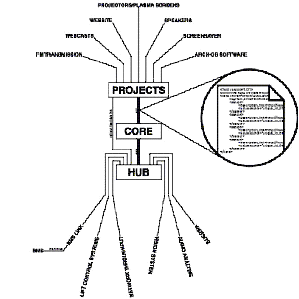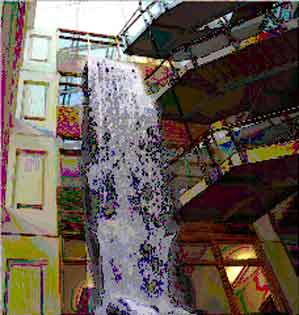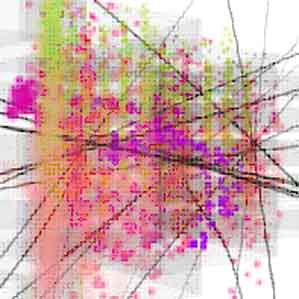The
entire electromagnetic spectrum is approximately 300,000,000,000,000,000,000,000,000,000,000,000
times larger than the human visible spectrum. [1] Arch-OS::Software
for Buildings is an operating system for architecture that employs
a wide range of embedded hardware and software technologies to gather
audio, visual, and raw data from numerous sources to bring a small
but significant slice of the imperceptible into our spectral range.
Developed by i-DAT (The Institute for Digital Art and Technology)
at the University of Plymouth in the UK, Arch-OS is incorporated
into the fabric of the University of Plymouth's Portland Square building.
Portland Square houses some of the University of Plymouth's most interesting
research, with a wide range of research initiatives in biomedicine,
neural-science, robotics, digital communications, interactive systems,
and emergent media. Arch-OS captures data through the Building Energy
Management System [BEMS], which monitors energy usage and environmental
control through the integration of over 2000 sensors. Arch-OS
also gathers data from the computer and communications networks, the
flow of people, ambient noise levels, and environmental conditions. |
|
During his presentation at ciber@rts Bilbao in April
of 2004, Mike Phillips, Director of I-DAT, revealed a number of
Arch-OS visualizations at work. Many of these examples
are available at the i-DAT website,
http://www.arch-os.com/. Phillips asserted thatArch-OS
has been developed to "manifest the life of a building and
provide artists, engineers and scientists with a unique environment
for developing transdisciplinary work and new public art."
[2] Arch-OS has indeed spawned an on-going cadre of research
by musicians, composers, digital artists, and trans-media collaborators.
For example, Eduardo Reck Miranda's digital audio composition, PSQ
Symphony #1, was performed for the opening of Portland Square
on 15 July, 2003. This generative sonic work feeds off real-time
data from the Arch-OS Core to re-synthesize and model vocalizations
sampled from a variety of monkeys, resulting in a variety of hybrid
voices and drum-and-bass-like rhythmic sequences. Considering
PSQ Symphony #1 from a cybernetic point of view, it is interesting
how data from the Core output is used to model this symphony, and
that this mediation (the symphony) -- when amplified into the Portland
Square interior -- becomes part of the updated Core input, initiating
a recursive, self-generative feedback loop. PSQ Symphony #1
is available for download at http://www.arch-os.com/media/psq1.html.
The Arch-OS website provides links to a
number of projects in nascent stages of development; among the ones
most interesting to me is the Water/data-fall project, where [BEMS]
data from the Arch-OS Core -- mapping real-time water usage
within the building -- is used to control the density of a projected
waterfall in the Atrium. Over time, occupants of the building "learn
to interpret the data flow, and this knowledge begins to influence
their collective behavior to reduce water consumption." [3]
During a conversation with Phillips on November 11, 2004, I learned
that some funding for the Water/data-fall project has been secured,
and that the project will be happening soon. Current projects include
Lab Culture, an artist residency involving ten artists; Lucy Kimball's
Making a Difference (http://www.i-dat.org/projects/makingdifference/);
and Mike Phillip's own recent implementation linking the Portland
Square site with the China Electronic Music Center, the Central
Conservatory of Music, and the Department of Digital Art and Design
at Peking University.
Arch-OS is clearly located within a trajectory
of socially responsive architectures that includes Archigram,
Potteries Thinkbelt (PtB), and the Fun Palace. These
visionary, post-war proposals marked "a shift from a determined
and mechanical architectural paradigm to the fluid and indeterminate
model of the information age" [4], defining a trajectory that
Arch-OS builds upon and extends into the future. As Cedric
Price's PtB proposed to utilize the vast railway networks
of the North Staffordshires, the networked Arch-OS virtualizes,
concretizes, and extends the agendas of Archigram, Fun Palace,
and Potteries Thinkbelt through a proactive advance into
a second-order social cybernetic model. According to Phillips, the
intention is to re-engineer or re-program a buildings' inhabitants
through the system. One could see it as part of a techno-ecological
agenda which, through the integration of intelligent and responsive
systems, engenders intelligent users. [5]
Arch-OS creates an architecture of becoming,
responsive to social forces and conditions, a "cybrid"
system, where "…physical and virtual domains become interdependent:
actions in the material and virtual spaces mutually affect one another."
[6]
Arch-OS is an extremely significant development
in architecture, urban planning, and art. Through making the invisible
elements of lived architecture tangible, Phillips and the members
of the Institute of Digital Art and Technology have created a unique
and dynamic interface for research, for collaborative, educational,
and cultural interventions, as well as a truly humanitarian work
environment.
Works cited:
[1] Howard C.
Hughes, Sensory Exotica, A World Beyond Human Experience (MIT
Press: Cambridge and London, 2001), p. 7
[2] Mike Phillips, "Soft Buildings" in Technoetic
Arts 2:2, (Intellect Press: Bristol, 2004), p. 98
[3] Water/data-fall, Research and Development Projects,
http://www.arch-os.com/projects/waterfall.html. Accessed January
3, 2005
[4] Stanley Mathews, Cedric Price and the architecture of 'calculated
uncertainty': The Fun Palace and Potteries Thinkbelt, Doctoral
Dissertation, New York: Columbia University, 2001.
[5] E-mail correspondence between reviewer and Mike Phillips, 11/11/2004
[6] Peter Anders, "The Cybrid Condition, Implementing Hybrids
of Electronic and Physical Space" in: Roy Ascott (ed.),
Reframing Consciousness (Intellect Press: Bristol, 1999),
p. 237
|



|
|

